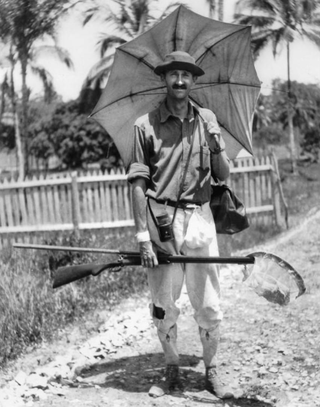
CharlesWilliam Beebe was an American naturalist, ornithologist, marine biologist, entomologist, explorer, and author. He is remembered for the numerous expeditions he conducted for the New York Zoological Society, his deep dives in the Bathysphere, and his prolific scientific writing for academic and popular audiences.

The Bathysphere was a unique spherical deep-sea submersible which was unpowered and lowered into the ocean on a cable, and was used to conduct a series of dives off the coast of Bermuda from 1930 to 1934. The Bathysphere was designed in 1928 and 1929 by the American engineer Otis Barton, to be used by the naturalist William Beebe for studying undersea wildlife. Beebe and Barton conducted dives in the Bathysphere together, marking the first time that a marine biologist observed deep-sea animals in their native environment. Their dives set several consecutive world records for the deepest dive ever performed by a human. The record set by the deepest of these, to a depth of 3,028 ft (923 m) on August 15, 1934, lasted until it was broken by Barton in 1949 in a vessel called Benthoscope.
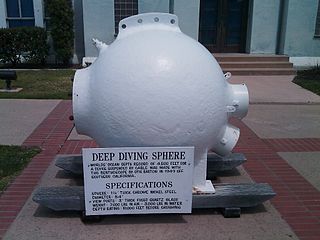
The Benthoscope was a deep sea submersible designed by Otis Barton after the Second World War. He hired the Watson-Stillman Company, who had earlier constructed his and William Beebe's bathysphere to produce the new design of deep diving vessel, which was named from the Greek benthos, meaning "bottom".

Idiacanthus atlanticus, the black dragonfish, is a barbeled dragonfish of the family Stomiidae, found circumglobally in southern subtropical and temperate oceans between latitudes 25°S and 60°S, at depths down to 2,000 metres (6,600 ft). The species is sexually dimorphic: females are black with six stripes; males are brown, and lack the females' canine teeth, pelvic fins and barbel. They can weigh between 13-15 grams. Females are believed to make a diel vertical migration from deeper than 500 metres (1,600 ft) by day to surface waters at night, whereas males do not migrate, remaining below 1,000 metres (3,300 ft) at all times.
Stomias boa boa, also called the scaly dragonfish or boa dragonfish, is a subspecies of abyssal barbeled dragonfish of the family Stomiidae. It is found at great depths worldwide in tropical to temperate oceans but is absent from the northern Pacific and northwest Atlantic Oceans.

The blacktip grouper, also known as the redbanded grouper, blacktipped cod, black-tipped rockcod, footballer cod, red-barred cod, red-barred rockcod, scarlet rock-cod or weathered rock-cod, is a species of marine ray-finned fish, a grouper from the subfamily Epinephelinae which is part of the family Serranidae, which also includes the anthias and sea basses. It is found in the tropical Indo-Pacific region. It is the type species of the genus Epinephelus.

The marbled grouper, donkey fish, mutton hamlet, rockhind and sicklefish grouper, is a species of marine ray-finned fish, a grouper from the subfamily Epinephelinae which is part of the family Serranidae, which also includes the anthias and sea basses. It is a predatory reef fish which is found in the Western Atlantic Ocean.

The snowy grouper is a species of marine ray-finned fish, a grouper from the subfamily Epinephelinae which is part of the family Serranidae, which also includes the anthias and sea basses. It is found in the western Atlantic Ocean.
The Venezuelan grouper is a species of marine ray-finned fish, a grouper from the subfamily Epinephelinae which is part of the family Serranidae, which also includes the anthias and sea basses. It is found in northern South America and the Greater Antilles.

Plectropomus laevis, known commonly as the black-saddled coral grouper, cluespotted coral trout, blacksaddled coral trout, blue-spot trout, Chinese footballer, footballer cod, footballer coral trout, oceanic coral trout or tiger trout, is a species of marine ray-finned fish, a grouper from the subfamily Epinephelinae which is part of the family Serranidae, which also includes the anthias and sea basses. It is found in the Indo-Pacific region.
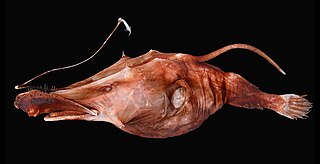
The complete anglerfish (Lasiognathus) is a genus of deep-sea anglerfish in the family Thaumatichthyidae, with six species known from the Atlantic and Pacific Oceans. Its lure apparatus appears to consist of a fishing rod, a fishing line, bait, and hooks. It is also distinctive for an enormous upper jaw with premaxillaries that can be folded down to enclose the much shorter lower jaw.
Clinoporus biporosus, the ladder klipfish, is a species of clinid found in subtropical waters of the Atlantic Ocean around the South African coast. It occurs in the subtidal zone down to a depth of 30 metres (98 ft). This species can reach a maximum length of 13 centimetres (5.1 in) TL. It is currently the only known member of the genus Clinoporus.
Blennioclinus stella, the Silverbubble klipfish, is a species of clinid found in subtropical waters of the southeastern Atlantic and western Indian Ocean along the South African coast down to a depth of about 10 metres (33 ft). This species can reach a maximum length of 5 centimetres (2.0 in) TL.
Clinus brevicristatus, the Cape klipfish, is a species of clinid that occurs in subtropical waters of the Atlantic Ocean around South Africa where it prefers habitats with plentiful growth of seaweed. This species can reach a maximum length of 12 centimetres (4.7 in) TL.

Idiacanthus is a genus of barbeled dragonfishes, the larvae of which are noted for exhibiting the Stylophthalmine trait.
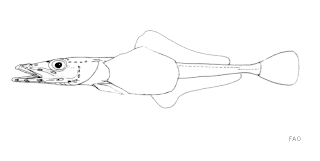
Vomeridens is a monotypic genus of marine ray-finned fish belonging to the family Bathydraconidae, the Antarctic dragonfishes, its only species is Vomeridens infuscipinnis. These fishes are native to the Southern Ocean.
The Galápagos ghostshark is a chimaera species in the family Chimaeridae, likely endemic to the Galápagos Islands. It was discovered by John E. McCosker in 1995 and described in 2006, scientifically named in honor of McCosker. This chimaera has a brown compressed, elongate body. The holotype and paratype of the species, both juvenile females, had a total length of 38.1 centimetres (15.0 in) and 22.7 centimetres (8.9 in), respectively. It lives in rocky habitats close to the sea floor, in waters about 395–510 metres (1,296–1,673 ft) deep. It is listed as least concern on the IUCN Red List.
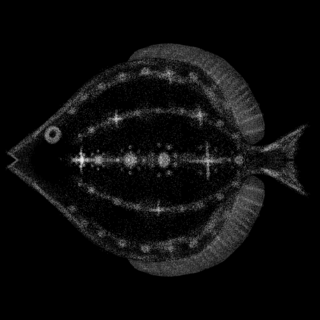
The five-lined constellation fish is species of fish that was described by William Beebe on 11 August 1934, being spotted by the biologist as he descended to a depth of 580 metres of the coast of Bermuda.

Bathyembryx istiophasma, the pallid sailfin, is hypothetical species of fish observed by William Beebe on 11 August 1934. He described seeing the species twice during the same dive at depths of 1,500 feet (460 m) and 2,500 feet (760 m) near the coast of Bermuda.
Opostomias micripnus, commonly known as the obese dragonfish, is a species of deep-sea ray-finned fish of the family Stomiidae found in the Atlantic, Indian and Pacific oceans. The species was described in 1878 by Albert Günther.













